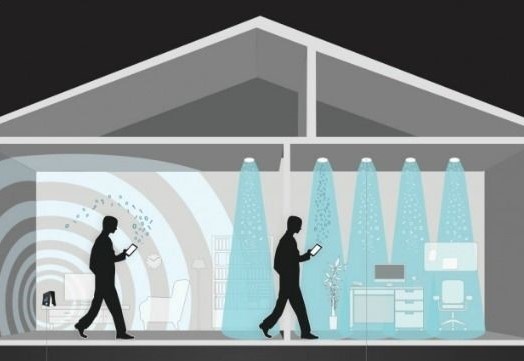 You may have missed it two years ago when Harold Haas demonstrated the first commercially available Li-Fi system at the 2014 Mobile World Congress in Barcelona. The man who coined the term Li-fi itself showed the world how this emerging, and very cool technology, can actually work as a consumer product. But you won’t be able to miss it soon. Li-Fi is about to go mainstream.
You may have missed it two years ago when Harold Haas demonstrated the first commercially available Li-Fi system at the 2014 Mobile World Congress in Barcelona. The man who coined the term Li-fi itself showed the world how this emerging, and very cool technology, can actually work as a consumer product. But you won’t be able to miss it soon. Li-Fi is about to go mainstream.
What is Li-Fi? Light Fidelity (Li-Fi) is a “bidirectional, high-speed and fully networked wireless communication technology similar to Wi-Fi.”
It is wireless, like Wi-Fi, but instead of using radio frequency spectrum, Li-Fi uses visible-light communication and near ultraviolet spectrum. It is considered part of optical wireless communications technology, which carries much more information than Wi-Fi. Also, it provides a solution to the looming spectrum crisis as Wi-Fi becomes close to full capacity. This is because with Li-Fi, there are virtually no limits on capacity—the visible light spectrum is 10,000 times larger than the entire radio frequency spectrum.
As for other benefits? It is fast. Researchers have reached data rates of over 10 Gbit/s, which is much faster than typical fast broadband in 2013. On top of that, it is expected to be ten times cheaper than Wi-Fi.
What are the downsides? There are three potential problems: short range, low reliability and high installation costs.
Li-Fi signals cannot pass through walls, so in order to enjoy full connectivity, capable LED bulbs will need to be placed throughout the home. Not to mention Li-Fi requires the lightbulb is on at all times to provide connectivity, meaning that the lights will need to be on during the day.
But thanks to its impressive speeds, Li-Fi could make a huge impact on the internet of things, with data transferred at much higher levels with even more devices able to connect to one another. What's more, due to its shorter range, Li-Fi is more secure than Wi-Fi and it's reported that embedded light beams reflected off a surface could still achieve 70 megabits per second.
For those looking for an investment opportunity, the Li-Fi market is projected to have a compound annual growth rate of 82% from 2013 to 2018 and to be worth over $6 billion per year by 2018.
A company called pureLiFi already have two products on the market: Li-Flame Ceiling Unit (which connects to an LED light fixture) and Li-Flame Desktop Unit (which connects to a device via USB). Both aim to provide light and connectivity in one device. A slightly bigger company called Apple has been reported to be building future iPhones with Li-Fi capabilities. One user found that within its iOS 9.1 code there were references to Li-Fi written as 'LiFiCapability'.
Hmmmm.
What strikes us about the development of Li-Fi is that the mediums and ways in which we can connect with each other and the world around us are seemingly limitless. From the invention of the telegram and telephone, to fax and pagers, to the internet and VoIP, to Wi-Fi and now Li-Fi… what is clear, is that there will definitely be something next.
But for now, we are looking forward to getting some Li-Fi bulbs!
About VTSL
VTSL is a hosted communications company and one of the leading VoIP providers in the UK, specialising in business phone systems, business connectivity solutions and unfied communications. Unlike many other VoIP providers, VTSL owns and manages its own network, develops is own proprietary applications and offers a user-friendly Web Portal designed in-house by VTSL's programmers. For more information on connectivity, unified communications or business phone systems email info@vtsl.net.

